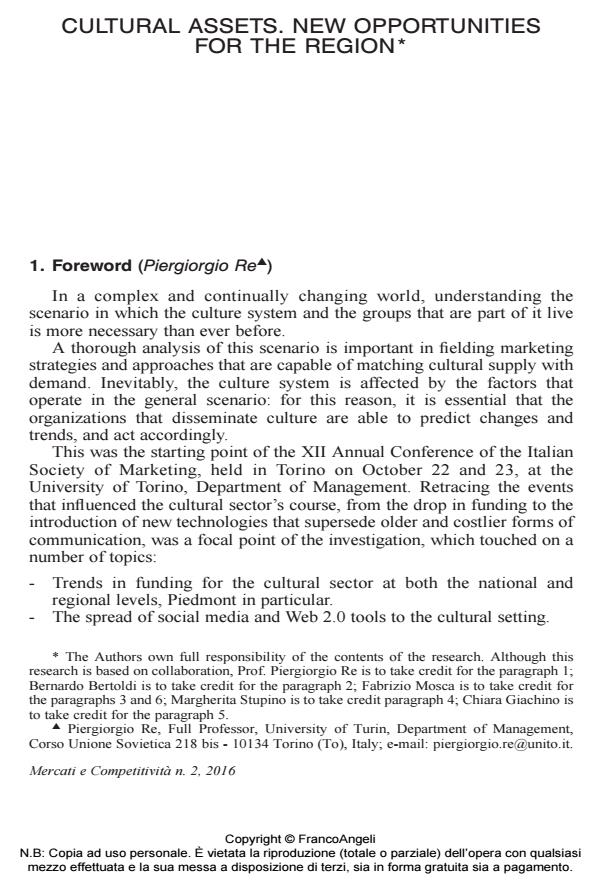Cultural assets. New opportunities for the region
Titolo Rivista MERCATI & COMPETITIVITÀ
Autori/Curatori Piergiorgio Re, Bernardo Bertoldi, Fabrizio Mosca, Margherita Stupino, Chiara Giachino
Anno di pubblicazione 2016 Fascicolo 2016/2 Lingua Inglese
Numero pagine 28 P. 13-40 Dimensione file 195 KB
DOI 10.3280/MC2016-002002
Il DOI è il codice a barre della proprietà intellettuale: per saperne di più
clicca qui
Qui sotto puoi vedere in anteprima la prima pagina di questo articolo.
Se questo articolo ti interessa, lo puoi acquistare (e scaricare in formato pdf) seguendo le facili indicazioni per acquistare il download credit. Acquista Download Credits per scaricare questo Articolo in formato PDF

FrancoAngeli è membro della Publishers International Linking Association, Inc (PILA)associazione indipendente e non profit per facilitare (attraverso i servizi tecnologici implementati da CrossRef.org) l’accesso degli studiosi ai contenuti digitali nelle pubblicazioni professionali e scientifiche
- Anderson P.F. (1982). Marketing, Strategic Planning and the theory of the Firm. Journal of Marketing, 15-26, DOI: 10.2307/3203337
- Bauman Z. (2006). Vita liquida. Roma-Bari: Laterza. Bazzi A. (2010). Le opportunità del digital Marketing determinano le strategie d’impresa, Mark up. SDA Bocconi.
- Berthon P.R., Pitt L.F., Plangger K. and Shapiro D. (2012). Marketing meets Web 2.0, Social Media, and creative consumers: Implications for international Marketing strategy. Business Horizons, 261-271, DOI: 10.1016/j.bushor.2012.01.007
- Blattberg R.C., Broderick C.J. (1991). Marketing of Art Museums. In The Economics of Art Museums, In M. Feldstein (ed.). The Economics of Art Museum. Chicago and London: University of Chicago press, 237-246.
- Bollo A. (2012). Il marketing della cultura. Milano: Carocci editore.
- Boulding K.E. (1977). Prices and other institutions. Journal of Economic Issues, 809-921, DOI: 10.1080/00213624.1977.11503486
- Bush J. (2004). Consumer Empowerment and Competitiveness. London: National Consumer Council.
- Camarero C., Garrido M.J. (2011). Incentives, Organisational Identification, and Relationship Quality among Members of Fine Arts Museums. Journal of Service Management, DOI: 10.1108/09564231111124253
- Cantone L., Risitano M. (2011). The role of DMOs in Tourism Stakeholders Systems. An empirical research in Italian context. Mercati e Competitività, 3: 105-125, DOI: 10.3280/MC2011-003007
- Chong D. (2007). Stakeholder Relationships in the Market for Contemporary Art. In Museums in the Material World.
- Christopher M. (1989). The Existential Consumer, European Journal of Marketing, 23, 8: 80-84.
- Conti E., Moriconi S. (2012). Le esperienze turistico-culturali: creare valore per i turisti culturali e gli stakeholders e valorizzare il patrimonio culturale della destinazione turistica. Il caso Marcheholiday. Mercati e Competitività, DOI: 10.3280/mc2012-004006
- Di Maio A. (1999). Economia dei beni e delle attività culturali. Liguori.
- Erdogmus I.E., Cicek M. (2012). The impact of Social Media Marketing on brand loyalty, 1353-1360, DOI: 10.1016/j.sbspro.2012.09.1119
- Forte F., Mantovani M. (2004). Manuale di economia e politica dei beni culturali. Roma: Rubbettino Editore.
- Franch M., Moretti A. and Pencarelli T. (2014). Introduzione. Arte, cultura e turismo nelle ricerche di marketing: contesto, contenuto e prospettive. Mercati e Competitività, 4: 15-17, DOI: 10.328/MC2014-004002
- Griswold W. (2005). Sociologia della cultura. Bologna: il Mulino.
- Howes D.S. (2007). Why the Internet Matters: A Museum Educator’s Perspective. In The Digital Museum: A Think Guide.
- Kidd J. (2011). Enacting engagement online: Framing Social Media use for the museum. Information Technology and People, 64-77, DOI: 10.1108/09593841111109422
- Kim J.H., Bae Z. (2008). The role of online brand community in new product development: case studies on digital product manufacturers in Korea. International Journal if Innovation Management, DOI: 10.1142/S1363919608002011
- Kroeber A.L., Kluckhohn C. (1952). Culture. A critical review of concepts and definitions, DOI: 10.2307/2103346
- Lyotard J.F. (1985). La condizione postmoderna. Milano: Feltrinelli.
- MacArthur M. (2007). Can Museums Allow Online Users to Become Participants?. In The Digital Museum: A Think Guide.
- Marty P.F. (2007). Museum Websites and museum visitors: Before and after the museum visit. Museum Management and Curatorship, 337-360, DOI: 10.1080/09647770701757708.
- McLean F. (1995). A Marketing Revolution in Museums?. Journal of Marketing Management, 601-616, DOI: 10.1080/0267257X.1995.9964370
- Merchant A., Ford J.B. and Sargeant A. (2010). ‘Don’t Forget to Say Thank You’: The Effect of an Acknowledgement on Donor Relationships. Journal of Marketing Management, 593-611, DOI: 10.1080/02672571003780064
- Pencarelli T., Splendiani S. (2008). Il governo delle destinazioni e dei prodotti turistici: analisi di alcune esperienze. Mercati e Competitività, 2: 91-121.
- Porter M.E. (2001). Strategy and the Internet. Harvard Business Review, Marzo, pp. 63-78.
- Rentschler R., Radbourne J. (2008). Relationship Marketing in the Arts: The New Evoked Authenticity. In The Routledge Companion to Nonprofit Marketing, 241-252, DOI: 10.4324/9780203936023.ch14
- Rha J.Y., Widdows R., Hooker N.H. and Montalto C.P. (2002). E-consumerism as a tool for empowerment. Journal of Consumer Education, 19 (20): 61-69.
- Severino F. (2005). Un marketing per la cultura. Milano: FrancoAngeli.
- Solima L. (2004). L’impresa culturale. Processi e strumenti di gestione. Carocci Editore.
- Touraine A. (2008). La globalizzazione e la fine del sociale. Milano: Il Saggiatore.
- Trimarchi M. (1993). Economia e cultura. Organizzazione e finanziamento delle istituzioni culturali. Milano: FrancoAngeli.
- Urban G. (2005). Don’t Just Relate – Advocate!: A Blueprint for Profit in the Era of Customer Power. USA: Wharton School Publishing.
- Weick K. (1997). Senso e significato nell’organizzazione. Milano: Cortina.
- Wind J., Mahajan V. (1997). Issues and opportunities in new product development: an introduction to the special issue. Journal of marketing research, 34 (February), 1-12, DOI: 10.2307/3152060
- Zabin J. (2009). The ROI of Social Media Marketing: Why it pays to drive word of Mouth. Aberdeen Group.
Piergiorgio Re, Bernardo Bertoldi, Fabrizio Mosca, Margherita Stupino, Chiara Giachino, Cultural assets. New opportunities for the region in "MERCATI & COMPETITIVITÀ" 2/2016, pp 13-40, DOI: 10.3280/MC2016-002002